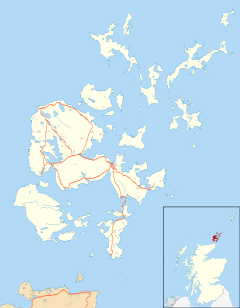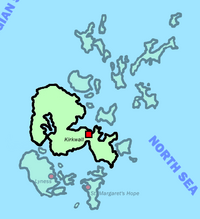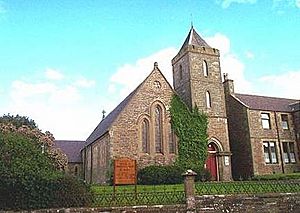Kirkwall facts for kids
Quick facts for kids Kirkwall
|
|
|---|---|
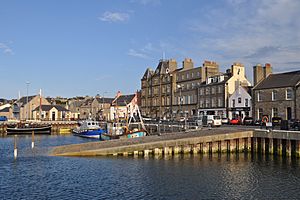 Kirkwall Harbour in August 2014 |
|
| Area | 3.63 km2 (1.40 sq mi) |
| Population | 7,500 (2020) |
| • Density | 2,066/km2 (5,350/sq mi) |
| OS grid reference | HY449109 |
| • Edinburgh | 210 mi (340 km) |
| • London | 528 mi (850 km) |
| Council area | |
| Lieutenancy area | |
| Country | Scotland |
| Sovereign state | United Kingdom |
| Post town | Kirkwall |
| Postcode district | KW15 |
| Dialling code | 01856 |
| Police | Northern |
| Fire | Highlands and Islands |
| Ambulance | Scottish |
| EU Parliament | Scotland |
| UK Parliament |
|
| Scottish Parliament |
|
Kirkwall (Scots: Kirkwaa, Scottish Gaelic: Bàgh na h-Eaglaise, Norn: Kirkavå) is the largest town in Orkney, an archipelago to the north of mainland Scotland.
The name Kirkwall comes from the Norse name Kirkjuvágr (Church Bay), which later changed to Kirkvoe, Kirkwaa and Kirkwall. Kirkwall was formerly the site of an ancient Norse town founded approximately 1000 years ago. Today, it is a transport hub with ferries to many locations.
Contents
Overview
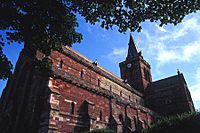
Situated on the northern coast of Mainland Orkney and with a population of about 9,000, Kirkwall is a port with ferry services to Aberdeen and Lerwick, as well as the principal north islands in the group. At the heart of the town stands St. Magnus Cathedral, which was founded in memory of Saint Magnus Erlendsson, Earl of Orkney 1108–1117 by Earl (later Saint) Rögnvald Kali. Next to the Cathedral are the ruins of the former Bishop's Palace and Earl's Palace. The town has two museums, the larger being Tankerness House Museum, which contains items of local historical interest within one of Scotland's best-preserved sixteenth-century town-houses. The prehistoric, Pictish and Viking collections are of international importance. The other museum is the Orkney Wireless Museum, dealing with the history of radio and recorded sound.
Apart from the main historical buildings mentioned above, Kirkwall has many 17th–18th-century houses and other structures in the local vernacular style. The 'Kirk' of Kirkwall was not the Cathedral (which was originally at Birsay), but the 11th-century church of Saint Olaf of Norway. One late medieval doorway survives from this church, and an aumbry from the original church survives within the late 19th-century structure of the present-day Saint Olaf's Church (Episcopal) in the town's Dundas Crescent. Kirkwall also once had a medieval castle, which was destroyed in the 17th century.
On the west edge of the town, surrounded by Hatston Industrial Estate, is a prehistoric ancient monument, Grain Earth House (Historic Scotland), a short low stone-walled passage deep underground leading to a small pillared chamber. This is the form of earth house or souterrain characteristic of the Northern Isles (although Grain is unusually deep below ground). It was originally connected to a surface dwelling, which has since disappeared, and the original purpose of these Iron Age structures remains unknown. Further west towards Grimbister is the similar Rennibister Earth House.
One of the major annual events in the town is the Ba Game, held each Christmas Day and New Year's Day between the Uppies and the Doonies, each team representing one half of the town. Kirkwall also has the most northerly of the world's Carnegie libraries, which was opened by Andrew Carnegie and his wife in 1909. The building survives, although the library has since moved to a larger building on Junction Road.
Climate
As with the rest of Scotland, Kirkwall experiences a maritime climate with cool summers, mild winters, often strong winds, plentiful rainfall, frequently overcast skies and sparse amounts of sunshine.
| Climate data for Kirkwall, 26m asl, 1981–2010, Extremes 1951– | |||||||||||||
|---|---|---|---|---|---|---|---|---|---|---|---|---|---|
| Month | Jan | Feb | Mar | Apr | May | Jun | Jul | Aug | Sep | Oct | Nov | Dec | Year |
| Record high °C (°F) | 12.2 (54.0) |
12.8 (55.0) |
18.9 (66.0) |
18.3 (64.9) |
22.0 (71.6) |
22.8 (73.0) |
25.6 (78.1) |
24.8 (76.6) |
22.8 (73.0) |
19.4 (66.9) |
14.5 (58.1) |
12.8 (55.0) |
25.6 (78.1) |
| Average high °C (°F) | 6.4 (43.5) |
6.4 (43.5) |
7.6 (45.7) |
9.5 (49.1) |
12.0 (53.6) |
14.0 (57.2) |
15.9 (60.6) |
16.0 (60.8) |
14.1 (57.4) |
11.4 (52.5) |
8.6 (47.5) |
6.8 (44.2) |
10.7 (51.3) |
| Average low °C (°F) | 1.9 (35.4) |
1.7 (35.1) |
2.4 (36.3) |
3.8 (38.8) |
5.6 (42.1) |
8.1 (46.6) |
10.2 (50.4) |
10.3 (50.5) |
8.8 (47.8) |
6.7 (44.1) |
4.2 (39.6) |
2.3 (36.1) |
5.5 (41.9) |
| Record low °C (°F) | −7.8 (18.0) |
−7 (19) |
−6.8 (19.8) |
−4.9 (23.2) |
−2.1 (28.2) |
1.0 (33.8) |
3.4 (38.1) |
3.7 (38.7) |
0.5 (32.9) |
−1.6 (29.1) |
−5.5 (22.1) |
−7.6 (18.3) |
−7.8 (18.0) |
| Average rainfall mm (inches) | 109.7 (4.32) |
93.3 (3.67) |
95.7 (3.77) |
60.3 (2.37) |
48.0 (1.89) |
52.7 (2.07) |
57.4 (2.26) |
66.3 (2.61) |
95.3 (3.75) |
126.0 (4.96) |
126.0 (4.96) |
107.8 (4.24) |
1,038.5 (40.89) |
| Average rainy days (≥ 1.0 mm) | 20.1 | 16.8 | 17.9 | 13.4 | 10.6 | 10.7 | 11.6 | 12.5 | 16.2 | 19.6 | 20.8 | 18.5 | 188.7 |
| Mean monthly sunshine hours | 32.2 | 59.3 | 98.2 | 136.8 | 190.0 | 148.6 | 132.2 | 129.7 | 105.3 | 75.8 | 40.1 | 24.5 | 1,172.4 |
| Source 1: Met Office | |||||||||||||
| Source 2: Royal Dutch Meteorological Institute/KMNI | |||||||||||||
Parliamentary burgh
Kirkwall was a parliamentary burgh, combined with Dingwall, Dornoch, Tain and Wick in the Northern Burghs constituency of the House of Commons of the Parliament of Great Britain from 1708 to 1801 and of the Parliament of the United Kingdom from 1801 to 1918. Cromarty was added to the list in 1832. The constituency was a district of burghs known also as the Tain Burghs until 1832, and then as the Wick Burghs. It was represented by one Member of Parliament until 1918, when the constituency was abolished and the Kirkwall component was merged into the county constituency of Orkney and Shetland.
Education
Kirkwall Grammar School has been established since circa 1200. The current school building was opened in 2014.
The Orkney College main campus is situated in Kirkwall, in a purpose-built building that opened in 2000.
Kirkwall has two primary schools, Papdale Primary School which opened in 1955 and Glaitness Primary School which opened in 1979.
Economy
Kirkwall harbour with nearly 1 kilometre (0.6 mi) of quay edge is the second commercial hub for Orkney after Hatston. There is a Marina, and support for fishing and dive vessels. After extensive work on harbour facilities, the town has become a popular cruise ship stop, with several ships arriving each week in the season. This has added to the prosperity of the town and allowed a thriving sector of independently owned shops. Each year now, 140 cruise ships visit Kirkwall and Stromness.
Weaving in Orkney took place from Viking times, with John Sclater & Co involved in Tweed production in Kirkwall in the 1970s. They used the brand names Norsaga and Jarltex.
Demography
The population of Kirkwall is continuously on the rise. The population was predicted to be about 10,000 in 2018.
Sport
The Pickaquoy Centre, Orkney's largest leisure centre, is located in Kirkwall, which opened in 1999 and was extended in 2014. It contains two pools, an indoor sports arena, squash courts, climbing wall, athletics track, synthetic and grass pitches and various exercise/gym studios.
Kirkwall Grammar School Sports Centre has indoor sports facilities, and grass and synthetic pitches, available to the public.
Transport
Kirkwall is a port with ferry services to Aberdeen and Lerwick, as well as the principal north islands in the group. Hatson pier, the main ferry terminal, is some 2 mi (3 km) outside the town centre.
The Aberdeen, Leith, Clyde & Tay Shipping Company operated steamer services to Kirkwall from 1836, with successor companies operating until 2002.
Kirkwall Airport, the main airport for Orkney, is 2+1⁄2 mi (4 km) southeast of the town. There are no passenger rail services in Kirkwall, the nearby railways having been industrial or military.
Notable people
- Conran of Orkney, 7th-century Bishop of the Orkneys
- Stanley Cursiter, Painter and Limner, was born in East Road
- Ola Gorie, jewellery designer
- Peter Marshall was educated in Kirkwall
- Clara Anne Williams (née Rendall), born Kirkwall 24 July 1887, missionary, teacher, and wife of Rev. Aeneas Francon Williams was awarded the Kaisar-i-Hind medal in 1946 for her work during WWII being in-charge of Red Cross work in Dooars, Bengal, India.
Images for kids
-
St. Magnus Cathedral dominates the Kirkwall skyline
See also
 In Spanish: Kirkwall para niños
In Spanish: Kirkwall para niños


